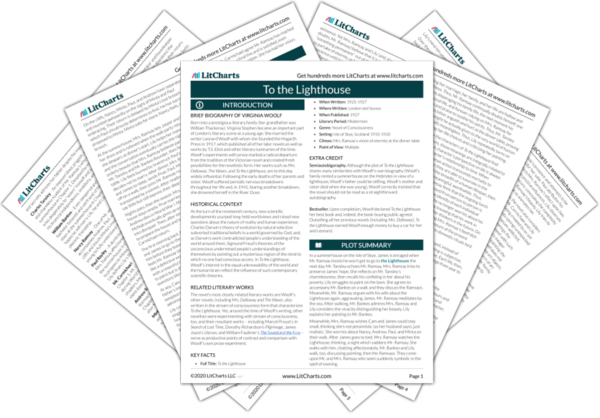Written as a stream of consciousness, To the Lighthouse constantly investigates the contours and patterns of human thought through its form and style. While writing within the perspective of a single character, Woolf’s sentences leap back and forth between various impressions, memories, and emotions, formally illustrating the associative nature of an individual mind. Lofty thoughts stand on par with everyday ones. Mrs. Ramsay’s mind alone leaps between thoughts on the nature of compassion, the relationship between men and women, household budgeting, her children’s futures, the state of her society, and the state of the beef dish she’ll be serving at dinner. Emotions, too, flash quickly in and out so that Mrs. Ramsay’s indignation at Mr. Ramsay’s exclamation “damn you” is restored to admiration just a few seconds later when he offers to double-check on the weather he has so adamantly insisted will be poor. While capable of such quicksilver change, the mind is also capable of extended preservation, so that Mr. Tansley’s insult floats in Lily’s mind ten years later even after she’s forgotten who said it.
Over the course of the novel, Woolf is also constantly leaping back and forth between the minds of different characters. Though everyone’s mind shares an associative, eclectic tendency, individual minds are also distinguishable enough from one another that Woolf sometimes doesn’t even have to indicate that she’s leapt from one person’s perspective to another’s, as when the text jumps from Lily’s to Mrs. Ramsey’s mind at the end of dinner in The Window. Likewise, Mr. Ramsay’s stream of consciousness is immediately distinguishable from Mrs. Ramsay’s in its lack of particular, material detail (the flowers, stars, and other such quotidian beauties that Mrs. Ramsay laments his inability to notice). As it slides in and out of different characters’ minds, the novel’s figuration further suggests that the divide between internal and external life might not be so rigid after all. Repeating metaphors of the mind as a pool of water and as a beehive transform abstract, private thought into a concrete, shared element of the natural world.
Every aspect of the novel speaks to the diversity of interior life: the diversity of disparate thoughts within an individual stream of consciousness as well as the diversity of different thoughts and thought patterns that characterize different individuals’ streams of consciousness. Lily’s reflection towards novel’s end that in order to see Mrs. Ramsey clearly a person would need “fifty pairs of eyes” (since each of those pairs would have such different insights into her character) can be read as a description of the novel itself: written through many separate pairs of eyes to achieve the most complete possible vision.
The Nature of Interior Life ThemeTracker

The Nature of Interior Life Quotes in To the Lighthouse
…the monotonous fall of the waves on the beach, which for the most part beat a measured and soothing tattoo to her thoughts and seemed consolingly to repeat over and over again as she sat with the children the words of some old cradle song, murmured by nature, ‘I am guarding you—I am your support’, but at other times suddenly and unexpectedly, especially when her mind raised itself slightly from the task actually in hand, had no such kindly meaning, but like a ghostly roll of drums remorselessly beat the measure of life, made one think of the destruction of the island and its engulfment in the sea, and warned her whose day had slipped past in one quick doing after another that it was all ephemeral as a rainbow…
All the being and the doing, expansive, glittering, vocal, evaporated and one shrunk, with a sense of solemnity, to being oneself, a wedge-shaped core of darkness, something invisible to others. Although she continued to knit, and sat upright, it was thus that she felt herself; and this self having shed its attachments was free for the strangest adventures. When life sank down for a moment, the range of experience seemed limitless. And to everybody there was always this sense of unlimited resources, [Mrs. Ramsay] supposed.
It partook, [Mrs. Ramsay] felt, carefully helping Mr. Bankes to a specially tender piece, of eternity; as she had already felt about something different once before that afternoon; there is a coherence in things, a stability; something, she meant, is immune from change, and shines out (she glanced at the window with its ripple of reflected lights) in the face of the flowing, the fleeting, the spectral, like a ruby; so that again tonight she had the feeling she had had once today already, of peace, of rest. Of such moments, she thought, the thing is made that remains for ever after. This would remain.
…there issued from [Mr. Ramsay] such a groan that any other woman in the whole world would have done something, said something—all except myself, thought Lily, girding at herself bitterly, who am not a woman, but a peevish, ill-tempered, dried-up old maid presumably.
















